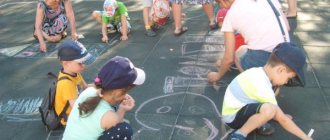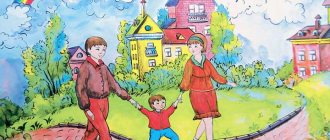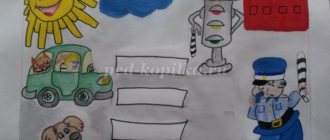Notes on cognitive development Topic: “My city” for middle group children
Transcript
1 Municipal budgetary preschool educational institution combined type kindergarten 49 “FAIRY” Abstract on cognitive development Topic: “My city” for children of the middle group Prepared by: teacher Margarita Nikolaevna Luneva, Stavropol, 2016
2 Topic: “My City” Goal: Continue to introduce children to their small homeland. Objectives: - Expand children's ideas about their hometown; — To evoke in children a feeling of admiration for the beauty of their hometown; — Teach children to draw a big house, convey the rectangular shape of the walls, rows of windows. — Develop the ability to complement the image based on impressions of the surrounding life. — To cultivate a love for one’s hometown and a sense of pride in it, a desire to make it even more beautiful. Vocabulary work: the city of Stavropol, names of streets, names of buildings (hospital, library, school, kindergarten, store). Materials: Photo stand “My Favorite City”, album sheets for drawing, wax pencils, recording of the song “Stavropol”. Preliminary work: city tour, memorizing poems about the city, looking at the photo album “The Nature of Our City,” conversations about the city of Stavropol, outings with children, application “Houses of the City.” Progress of the lesson: Educator: Guys, let's stand in a circle. Show your palms. Rub them together. What do you feel? (Warm). This is the warmth of kind hands and kind souls. We offer our warmth, our palms to our friends and say: The morning is coming, the sun is rising. We're getting ready and going on a good journey. Let's look at each other, talk to ourselves: “Who is good? Who’s handsome among us?” (Children take turns calling each other affectionate words). Educator: I am very pleased that you are such affectionate, kind, skillful guys. It is interesting to talk with such children. (Draws the children's attention to the photographs). Look carefully at the photographs and say what they show. (Children's answers).
3 Educator: Guys, what is the name of the city in which we live? (Stavropol) It is located in the central part of the North Caucasus. Educator: There are a lot of big and small cities in the world. And we will talk about our city, about our most beloved, about the most beautiful. Did I say correctly that our city is the most beautiful? (children's answers) Educator: Please tell me what you like about our city? (children's answers). Educator: There are many streets in our city. And each street has its own name. Tell me what street do you live on? (children's answers) Educator: Guys, you walk along familiar streets every day. What buildings can you see on the streets of our city? (Shops, post office, pharmacy, hospital, school, library, kindergarten). Educator: There are many different buildings in our city. But there is one large, spacious building that both adults and children love to come to. Educator: Who recognized this building? (children's answers) Educator: Many of you went to the drama theater to watch performances, a circus performance. The drama theater not only shows performances, but also holds various concerts at which artists sing, dance and read poetry. Let us now turn into little artists and play musical instruments. (Children play musical instruments to Russian folk melody). Educator: Who cares about the beauty of our city? (Adults). How do they care? (Adults plant trees, flowers, remove garbage). Educator: Correct. Adults are trying to make our city beautiful and cozy. They want all people to live a fun and interesting life in our city. Therefore, we must take care of what is made by the hands of adults, maintain cleanliness and order. Physical exercise: We get up early in the morning and see the city outside the window. He woke up, he lives. He's calling us outside.
4 Educator: All people love their city in which they live. They write poems and songs about their hometown. We also know poems about our hometown. (Reading poetry). Poem by Gennady Fateev. There is a city in the world, a southern city, a piece of my homeland. He rushes from the fields to the mountains, covered in a necklace of poplars. It is all filled with warmth and light, It enchants us with a river of flowers. Through your eyes, Stavropol, Russia looks at the Caucasus. Again on the Cathedral Hill I stand by the Eternal Flame. And everything that happened in the past, distant, excites and touches me. More than once there was smoke around the field, the cruel enemy destroyed houses. But the thunderstorms did not break your people, your soul. And I don’t need any other fate than the one I live by. I love this southern city, I am with it in my dreams and in reality. And at two hundred years old he is just as young, covered in a necklace of poplars. Live and hello, dear city, Part of my Motherland. Poem by Vladimir Avdeev “My Stavropol Region”. My Stavropol region, you are in the south of Russia, lying among two blue-eyed seas. Smiling, you look into the blue skies, And your soul becomes kinder from your smile. Schools of cranes fly over you, carrying the smell of your relatives' arable lands to a distant land. Only I don’t want to fly away from you, from fields and forests, from your expanses.
5 Our grandfathers plowed this land. It was as if her mother were protecting her from her enemies. And we bequeathed to our descendants to take care of our native land, And we protect you, my Stavropol region! Conclusion: You told a lot about our city. They said correctly that we have many streets, houses, beautiful nature. There are many people working in our city who want our city to become better, more beautiful and richer. Educator: Now let's go for a walk around our city. Whoever finds a photograph of our city shows it to all the children (photos of Stavropol and other cities are laid out on the table). Educator: And now, I suggest everyone draw their own home. (Productive activities of children. A recording of the song “Stavropol region” is played). Educator: Look how many beautiful houses you have drawn (built). It turned out to be a whole city. Children look at the work.




